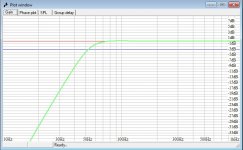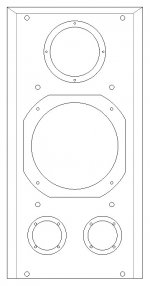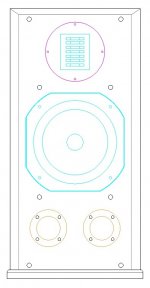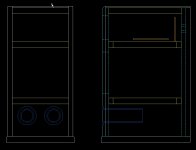Are we there yet? 🙂
So I've attached a zip file with my WinISD results.
It includes the WinISD file and a text file with the results and design.
I think it looks pretty good. (but I'm a Rookie).
My enclosure design currently has an internal volume of 1417.5 Cubic Inches.
This was actually derived from the Fat Box formula referenced from my textbooks and targeting 1400 Cubic inches. (See attached text file).
So Imperialistic calculations. I did this as a base line volume.
WinISD calculates the "Optimum" volume to be 2100 Cu.In.
A 50% addition to imperialistic volume.
Another reference suggested adding 25% to imperialistic volume.
Which would be 1750 Cu.In.
So my first question?
Does WinISD calculate optimum volume by oversizing the enclosure to account for "Normal" Batting?
and/or
Do I need to add volume to the base line, for example the recommended 25% increase.
So I've attached a zip file with my WinISD results.
It includes the WinISD file and a text file with the results and design.
I think it looks pretty good. (but I'm a Rookie).
My enclosure design currently has an internal volume of 1417.5 Cubic Inches.
This was actually derived from the Fat Box formula referenced from my textbooks and targeting 1400 Cubic inches. (See attached text file).
So Imperialistic calculations. I did this as a base line volume.
WinISD calculates the "Optimum" volume to be 2100 Cu.In.
A 50% addition to imperialistic volume.
Another reference suggested adding 25% to imperialistic volume.
Which would be 1750 Cu.In.
So my first question?
Does WinISD calculate optimum volume by oversizing the enclosure to account for "Normal" Batting?
and/or
Do I need to add volume to the base line, for example the recommended 25% increase.
Attachments
Last edited:
Well I just remembered that WinISD calculates "Outer" Dimensions based on thickness.
All the same, what is recommended regarding adding volume to account for batting?
All the same, what is recommended regarding adding volume to account for batting?
Recalculating the WinISD Optimum volume to internal dimensions results in 1403.65.
Close enough to exact at 23 Liters.
So my current design volume of 1417.5 is just a tad larger.
Close enough to exact at 23 Liters.
So my current design volume of 1417.5 is just a tad larger.
Well I just remembered that WinISD calculates "Outer" Dimensions based on thickness.
All the same, what is recommended regarding adding volume to account for batting?
Huh?! Don't currently have any version loaded, but the two versions I've used [pro, 0.7] calculates net Vb like every other program, so doesn't include the driver, vent, bracing, etc., and any fibrous damping is presumed to be too little to be considered.
There is an old rule-of-thumb to add 10% to cover all this though.
FWIW, at a glance and based on published specs I would put the 1411 in a ~1775"^3 net cab.
GM
Thanks GM,
So that is very close to the 25% increase from base at 1750.
But you were recommending or not the 10% ROT?
So how did you come to the 1775 Net conclusion?
Appreciate your input.
So that is very close to the 25% increase from base at 1750.
But you were recommending or not the 10% ROT?
So how did you come to the 1775 Net conclusion?
Appreciate your input.
You're welcome!
FYI, I used a proprietary speaker design routine that predates T/S by several decades, but if you sim it in T/S you'll find that it provides an optimum compliance referenced to driver Vas, so not a fixed percentage and of course only as accurate as the Vas spec.
No, just a bit of history relative to this 25% suggestion I don't recall ever knowing about. I come from a time when speaker efficiency was a prime design goal, so I normally design cabs quite a bit larger than what T/S recommends and if it 'booms', 'rings', then 'critically' damp it to ~ 'have my cake and eat it too' same as the pioneers did.
Anyway, in your case I recommend using WinISD to calculate approximately how much volume the driver takes up + calculate any loss from bracing, etc., and add it since the cab is physically small, so adding 10% might not be enough.
Then again, many folks don't notice any obvious difference in sealed bass performance until the system Q [sysQ] is very low [rolled off bass] or very high [mid-bass 'boom'], so we're talking 'nit-picking' theory on a subject where there's so much latitude in cab size that it's mostly moot.
GM
FYI, I used a proprietary speaker design routine that predates T/S by several decades, but if you sim it in T/S you'll find that it provides an optimum compliance referenced to driver Vas, so not a fixed percentage and of course only as accurate as the Vas spec.
No, just a bit of history relative to this 25% suggestion I don't recall ever knowing about. I come from a time when speaker efficiency was a prime design goal, so I normally design cabs quite a bit larger than what T/S recommends and if it 'booms', 'rings', then 'critically' damp it to ~ 'have my cake and eat it too' same as the pioneers did.
Anyway, in your case I recommend using WinISD to calculate approximately how much volume the driver takes up + calculate any loss from bracing, etc., and add it since the cab is physically small, so adding 10% might not be enough.
Then again, many folks don't notice any obvious difference in sealed bass performance until the system Q [sysQ] is very low [rolled off bass] or very high [mid-bass 'boom'], so we're talking 'nit-picking' theory on a subject where there's so much latitude in cab size that it's mostly moot.
GM
I like your suggestion. I have been a little worried about under sizing.
You can always add the appropriate amount of batting in a slightly over sized cabinet.
Tune it by ear until it sounds good.
But you can't add volume to an under sized cabinet.
You can always add the appropriate amount of batting in a slightly over sized cabinet.
Tune it by ear until it sounds good.
But you can't add volume to an under sized cabinet.
Last edited:
My next question would be regarding Port Tubes.
1) should I flush mount my port(s) to the baffle?
2) should ports be free and clear from any damping material or should they be lightly damped?
Mind you, I am aware the port tube entries should be free and clear of any damping material.
Thanks for any input.
1) should I flush mount my port(s) to the baffle?
2) should ports be free and clear from any damping material or should they be lightly damped?
Mind you, I am aware the port tube entries should be free and clear of any damping material.
Thanks for any input.
Hmm, thought this was a sealed alignment.
?? Folks normally do for looks, though it's a good plan since it otherwise disrupts the baffle's eigenmodes.
For empirically fine tuning them though, best to leave them out far enough to be able to easily remove them, just make sure it's well sealed at the baffle since even pin holes have been known to 'destroy' the ability to tune the cab. There have been plenty of times when air seeping around T-nut screw threads has been the culprit. Ditto accordion surrounds with pinholes in the doping or over-tightening hardware destroyed the gasket seal.
Ideally, there shouldn't be any damping near, or in, the vent to maximize its efficiency, but the reality is that its damping usually makes or breaks the speaker's low end performance, especially WRT perceived sound quality [SQ], i.e. 'fast', 'tight', etc..
GM
?? Folks normally do for looks, though it's a good plan since it otherwise disrupts the baffle's eigenmodes.
For empirically fine tuning them though, best to leave them out far enough to be able to easily remove them, just make sure it's well sealed at the baffle since even pin holes have been known to 'destroy' the ability to tune the cab. There have been plenty of times when air seeping around T-nut screw threads has been the culprit. Ditto accordion surrounds with pinholes in the doping or over-tightening hardware destroyed the gasket seal.
Ideally, there shouldn't be any damping near, or in, the vent to maximize its efficiency, but the reality is that its damping usually makes or breaks the speaker's low end performance, especially WRT perceived sound quality [SQ], i.e. 'fast', 'tight', etc..
GM
Nope. Sorry. I have a previous thread, similar title, defining the project.
The LF Driver is a Focal 8W 5411.
They recommend a vented enclosure.
Thanks for the warning on losses. I planned to build tight, but thought it was more important for sealed boxes. You know, there's that big hole there. 🙂
The LF Driver is a Focal 8W 5411.
They recommend a vented enclosure.
Thanks for the warning on losses. I planned to build tight, but thought it was more important for sealed boxes. You know, there's that big hole there. 🙂
I'm not sure what role these will play.
First, they will replace my age old ESS AMT-5 Bookshelves. (Like they would sit on a self !?!).
Long last, I will miss them.
So I suppose main monitors in my small living room. (No TV's allowed) 🙂
Maybe later they will be good surrounds.
Or end up in my Shop. Ha!
First, they will replace my age old ESS AMT-5 Bookshelves. (Like they would sit on a self !?!).
Long last, I will miss them.
So I suppose main monitors in my small living room. (No TV's allowed) 🙂
Maybe later they will be good surrounds.
Or end up in my Shop. Ha!
LOL! 😀 Yeah, a lot of folks have a hard time 'wrapping their head around' how this huge 'leak' works and worrying about it spitting the fiberglass, whatever insulation out on deep bass notes.
I usually post this neat animation, but apparently it too is a bit much for some: Welcome Secrets of Home Theater and High Fidelity
GM
I usually post this neat animation, but apparently it too is a bit much for some: Welcome Secrets of Home Theater and High Fidelity
GM
Last Question is regarding bracing.
I designed a pretty simple H-Brace.
Looking through some of the amazing designs on this forum, I saw some 1" MDF designs that were pretty cool. They had rounded all the sharp edges off. very smooth.
Is this something most folks do?
I designed a pretty simple H-Brace.
Looking through some of the amazing designs on this forum, I saw some 1" MDF designs that were pretty cool. They had rounded all the sharp edges off. very smooth.
Is this something most folks do?
As small as this cab is, it doesn't take much to make it rigid enough, plus it ideally needs a bit of weight, so you could use 1.25" thick MDF [laminated 3/4", 1/2"] and skip bracing. This makes it as rigid as using 19 mm BB ply or similar at a fraction of the cost plus it's easier overall to finish.
For round overs, the radius needs to be large enough for the eigenmodes to be long enough to slide over the edge for lack of a better description, so in general, the corner radius would be quite large, ergo most all rounded over cabs are strictly cosmetic, which of course makes it worthwhile for many folks. I just use open cell foam 'walls' or cover the whole driver area for when I want it for acoustical reasons.
GM
For round overs, the radius needs to be large enough for the eigenmodes to be long enough to slide over the edge for lack of a better description, so in general, the corner radius would be quite large, ergo most all rounded over cabs are strictly cosmetic, which of course makes it worthwhile for many folks. I just use open cell foam 'walls' or cover the whole driver area for when I want it for acoustical reasons.
GM
Thanks GM, all good stuff.
I would have never thought to round the edges of my brace.
This forum is certainly paying off.
I'll probably just stick with my simple brace and round the edges.
Now I just need to get down to the hardware store and order my 1" MDF.
Lucky for me I know an excellent cabinet maker who has an amazing shop.
And he's excited to help me build my cab, since he is a musician.
Well off to the races then.
I would have never thought to round the edges of my brace.
This forum is certainly paying off.
I'll probably just stick with my simple brace and round the edges.
Now I just need to get down to the hardware store and order my 1" MDF.
Lucky for me I know an excellent cabinet maker who has an amazing shop.
And he's excited to help me build my cab, since he is a musician.
Well off to the races then.
Here are some sketches of the newly sized cab.
External Dimensions (Inches): 11w X 15.75d X 23h
1" Baffle, Braces and Base.
3/4" Rear Baffle and Sides.
Kinda hard to imagine the true plan.
Nothing fancy.
External Dimensions (Inches): 11w X 15.75d X 23h
1" Baffle, Braces and Base.
3/4" Rear Baffle and Sides.
Kinda hard to imagine the true plan.
Nothing fancy.
Attachments
Ideally need to rethink the bracing scheme a bit and include driver, vent brace/mass loading......... more to come, browse these cab drawings in the meantime to see where I'm headed: Frugal-phile | Box Library
GM
GM
OK, look forward to understanding.
Just to clarify, the bottom brace is the only real "brace".
What looks like the middle brace is really the enclosure top. (Solid).
The top of the Cabinet will look similar to the bottom brace, with cutouts to access the crossovers. It's also hosting the AMT.
The top will also be covered with 1/4" Smoked Glass to hide the crossovers.
Just to clarify, the bottom brace is the only real "brace".
What looks like the middle brace is really the enclosure top. (Solid).
The top of the Cabinet will look similar to the bottom brace, with cutouts to access the crossovers. It's also hosting the AMT.
The top will also be covered with 1/4" Smoked Glass to hide the crossovers.
I think I see where your going.
The Vertical braces with all the holes supporting the back of the driver?
Boy Howdy, how do you determine the hole diameters and patterns?
Just random?
The Vertical braces with all the holes supporting the back of the driver?
Boy Howdy, how do you determine the hole diameters and patterns?
Just random?
- Status
- Not open for further replies.
- Home
- Loudspeakers
- Multi-Way
- ESS-Focal 2 Way (The Enclosure)



